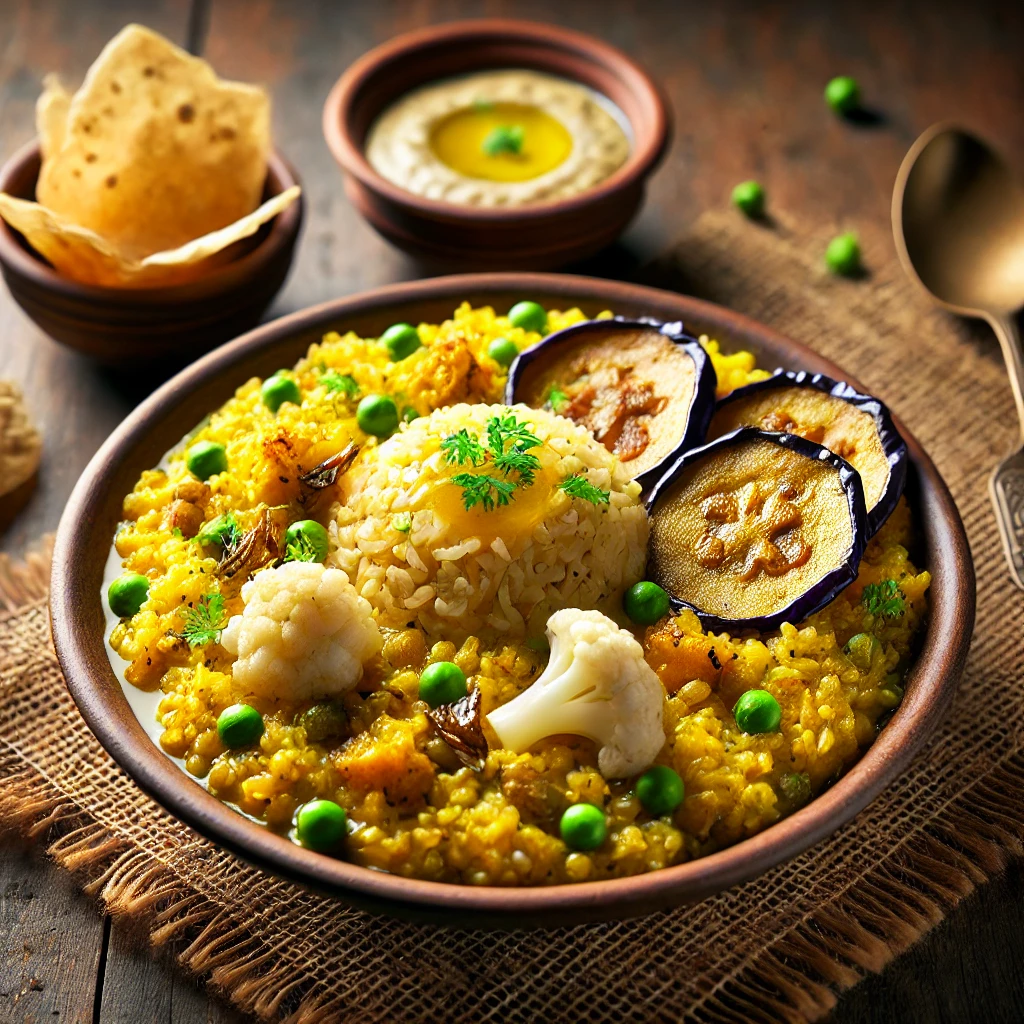Why Khichuri is India\u2019s Ultimate One-Pot Comfort MeaKhichdi: The Ultimate Ayurvedic Detox Food
In the ever-expanding world of health and wellness, ancient wisdom often provides timeless solutions to modern challenges. One such gem from Ayurvedic tradition is Khichdi – a simple, wholesome dish that has been a cornerstone of Indian cuisine and holistic healing for centuries. Renowned for its nourishing, detoxifying, and balancing properties, khichdi is much more than comfort food; it’s a testament to the Ayurvedic principle of achieving harmony within the body.
What is Khichdi?
Khichdi, pronounced “kitch-ree,” is a versatile dish made by cooking rice and lentils (or mung dal) together, often seasoned with spices and sometimes enriched with vegetables. While its ingredients can vary regionally and personally, its essence remains the same: a warm, soft, and easily digestible one-pot meal. This simplicity makes it a staple in households across India and a popular choice for those recovering from illness or seeking a light yet nourishing meal.
Ayurvedic Perspective on Khichdi
In Ayurveda, food is considered medicine, and khichdi epitomizes this principle. Its unique combination of ingredients aligns with Ayurvedic wisdom to create a dish that balances all three doshas – Vata, Pitta, and Kapha. Here’s how:
- Rice: Cooling and grounding, rice calms Pitta and Vata while being gentle on the digestive system.
- Mung Dal (split yellow lentils): Considered tridoshic (balancing for all doshas), mung dal is light, protein-rich, and easy to digest, unlike heavier lentils.
- Ghee: Clarified butter, or ghee, is celebrated in Ayurveda for its ability to lubricate the digestive tract, improve nutrient absorption, and pacify Vata and Pitta.
- Spices: Cumin, turmeric, ginger, coriander, and asafoetida (hing) not only enhance flavor but also stimulate digestion, reduce bloating, and provide anti-inflammatory benefits.
Together, these ingredients create a meal that detoxifies the body, boosts immunity, and restores balance.
Why is Khichdi the Ultimate Detox Food?
- Easily Digestible: Khichdi’s soft texture and simple ingredients make it easy to digest, ensuring minimal strain on the digestive system. When the body isn’t overburdened by digestion, it can focus on eliminating toxins (ama) and healing.
- Cleansing and Detoxifying: The combination of rice and mung dal acts as a gentle cleanser for the gut, flushing out impurities without depleting the body’s energy reserves. Spices like turmeric and ginger further aid in detoxification by promoting liver function and reducing inflammation.
- Balances Gut Health: A well-functioning gut is crucial for overall health. Khichdi’s probiotic-friendly nature, especially when paired with a dollop of ghee, supports a healthy microbiome and enhances digestion.
- Customizable for Doshas: Khichdi can be tailored to suit individual doshic imbalances. For instance:
- For Vata imbalance: Add extra ghee and grounding spices like cinnamon or nutmeg.
- For Pitta imbalance: Use cooling spices like fennel and omit chilies.
- For Kapha imbalance: Incorporate warming spices like black pepper and mustard seeds, and add more vegetables to reduce heaviness.
- Nutrient-Dense: Despite its simplicity, khichdi is packed with essential nutrients. It provides carbohydrates for energy, protein for repair and growth, healthy fats for sustained energy, and a plethora of vitamins and minerals from spices and vegetables.
How to Make Ayurvedic Khichdi
Here’s a basic recipe to prepare a nourishing bowl of khichdi:
Ingredients:
- 1/2 cup white basmati rice
- 1/2 cup yellow mung dal (split yellow lentils)
- 4-5 cups water (adjust for desired consistency)
- 1-2 tablespoons ghee
- 1/2 teaspoon cumin seeds
- 1/4 teaspoon turmeric powder
- 1/2 teaspoon grated ginger
- A pinch of asafoetida (hing)
- Salt to taste
- Optional: Chopped vegetables (carrots, zucchini, spinach, etc.)
Instructions:
- Rinse the rice and mung dal thoroughly until the water runs clear.
- In a heavy-bottomed pot, heat ghee and add cumin seeds. Once they splutter, add grated ginger, turmeric, and asafoetida.
- Add the rinsed rice and mung dal, stirring to coat them with the spices.
- Pour in the water, add salt, and bring to a boil.
- Lower the heat, cover, and simmer until the rice and lentils are soft and mushy (approximately 25-30 minutes). Stir occasionally to prevent sticking.
- Adjust the consistency with water if needed, and serve hot with a dollop of ghee.
Incorporating Khichdi into Your Routine
Khichdi can be enjoyed as part of a detox regimen or integrated into daily meals for its numerous health benefits. Here are some tips:
- Detox Days: Dedicate one or two days a week to eating only khichdi and herbal teas. This practice gives your digestive system a break and rejuvenates your body.
- Post-Illness Recovery: After an illness or during periods of low energy, khichdi provides essential nutrients in an easily digestible form.
- Everyday Meal: Pair khichdi with a side of yogurt or pickles for a balanced and satisfying meal.
Beyond Food: Khichdi as a Symbol of Balance
Khichdi’s appeal goes beyond its nutritional value. It embodies the Ayurvedic principle of balance – balancing flavors, nutrients, and energies. Its simplicity reminds us to slow down, savor the present moment, and nourish ourselves holistically.
In today’s fast-paced world, where fad diets and complex superfoods often dominate, khichdi’s timeless wisdom offers a refreshing perspective. It’s a reminder that sometimes, the simplest solutions are the most profound.
Final Thoughts
Khichdi isn’t just food; it’s a celebration of health, tradition, and balance. Whether you’re seeking a detox, a comforting meal, or a connection to ancient wisdom, khichdi is the ultimate answer. So, the next time you’re looking to reset your body and mind, turn to this humble yet powerful dish. Your body will thank you for it.

